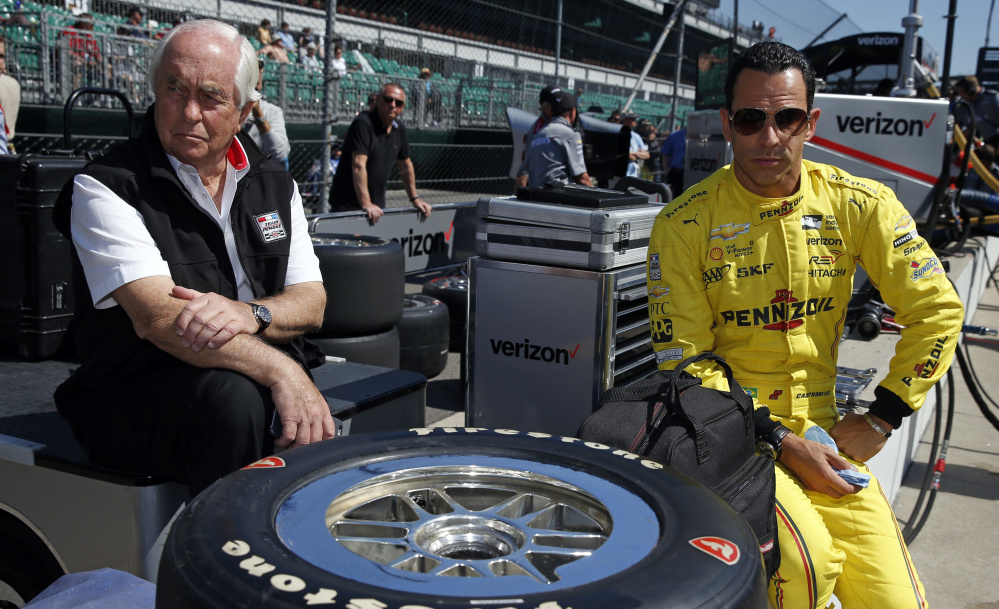INDIANAPOLIS — It was 1951 when Jay Penske scored a pair of tickets to the Indianapolis 500. He was an executive for a metal fabrication company in Cleveland that was sponsoring a few laps in the race, so he brought his 14-year-old son to Indianapolis Motor Speedway.
Roger Penske, already a car lover, was instantly hooked. He had listened to previous Indy 500s on the radio, but was now seeing it in person for the first time.
“We drove here from Cleveland and got here late and were supposed to go to someone’s home for lunch,” Penske recalled. “Everybody was gone but there was a car there. I got my picture taken with a Cromwell helmet on.”
That day, Penske said, he wanted to drive. And he would come to the track every year after for the next four decades.
“I think the speed here, the sensation of the track, and if you love cars like I did in those days, it was a place you wanted to be part of,” Penske said.
From that first trip to the speedway to present day, Penske has missed just six Indianapolis 500s. There was 1995, a year after Al Unser Jr. won the race for Team Penske, when his cars failed to qualify. Then he took a five-year hiatus when IndyCar split from CART and Penske remained with the series that was not welcome at the Indianapolis 500.
There have been precious few low points for the billionaire team owner whose influence stretches across both IndyCar and NASCAR. As Penske celebrates his 50th year in racing, during the 100th running of the Indianapolis 500, the mark he’s left on the motor sports community is unrivaled. In an Associated Press survey of the 27 living winners of the Indy 500, Penske fell just four votes shy of longtime track owner Tony Hulman as the most important non-driver at Indianapolis Motor Speedway.
“He’s been there such a long time, he prepares things to such a significantly high level of professionalism,” said 1996 winner Buddy Lazier.
He wanted to be a race car driver. His father wanted him to be an entrepreneur, and his son spent time in military school learning the discipline and standard of excellence that he maintains today at age 79.
Penske indeed briefly dabbled in auto racing and was quite good. But he had a job at Alcoa and couldn’t get the time off needed to properly race. So he retired from racing in 1965. He was trying to buy a Chevrolet dealership in Philadelphia, but General Motors didn’t want to give a franchise to a race car driver. Using a loan from his father to buy his first dealership, Penske had to step away from racing to focus on earning back the funds needed to repay dad.
“I had to make a pretty good business decision at that point: Do I continue racing or do I go into business?” Penske said. “I think I made the right decision, because I was able to have the experience as a driver, understood what it meant to have reliable and great cars, and was able to bring that into our team a few years later. From that point, we never looked back.”
NASCAR: Martin Truex Jr. won the pole for the Coca-Cola 600 on Sunday, NASCAR’s longest race of the year. Truex turned a lap of 192.328 to take the top spot from Joey Logano.
Logano, who had the top qualifying time in the first two rounds and won the All-Star race last week at Charlotte Motor Speedway, will start alongside Truex on the front row. It is the fifth time this year Logano has started on the front row.
Ricky Stenhouse Jr. will start third, Denny Hamlin fourth and Brad Keselowski fifth.
FORMULA ONE: Champion Lewis Hamilton posted the fastest time Thursday in an eventful first practice session of the Monaco Grand Prix, a race he has not won since 2008. Hamilton is chasing a third straight title and fourth overall but trails Mercedes teammate Nico Rosberg by 43 points.
Send questions/comments to the editors.


